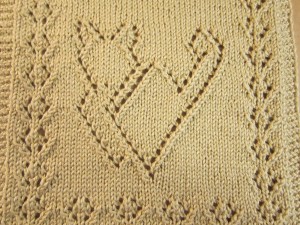I hope you’ve found that Kitty In Your Lap Towel is an easy to follow and enjoyable “moose lace” project. For beginners, it should be a nice experience in lace since it is on larger needles with larger yarn than the typical lace. Even more experienced lace knitters can enjoy knitting moose lace. Who says that lace has to always be knit on tiny needles with teensy yarn/thread, lol?
The resting rows (i.e. alternating plain knit/purl rows without lace patterning) can help to move things along smoothly. It’s another plus for beginners, and even for the more experienced wanting a knitting project where we can “zone out” now and then.
In its most elemental form, lace is just a bunch of holes arranged into a pleasing pattern. For example, here is a simple graphic of the Kitty In Your Lap Pattern showing the lace holes only.
I think that what makes lace design so intriguing beyond just the holes is the texture that complements the lace. The slant of the compensating decreases, and other twists and turns of the stitches in the fabric create an extra dimension of interest.
My kitty lace motif above was inspired by Dorothy Reade’s “Peruvian Cat”. Although I never actually met Dorothy, she definitely was an inspiration in my introduction and upbringing in lace. Most significantly, in her designs I noticed how she liked to make a k1tbl 2 rows above where a yarn over had been made. It is a subtle detail that gives a bit more definition/sharper line above the yarn overs than if just working a plain k1. This is because the k1tbl twists the loop of the stitch just below it, therefore giving a firmer line to the upper part of the yarn over hole.
Making a k1tbl 2 rows/rounds above a yarn over is a technique that I introduced in the Pretty Awesome Yarn Pouch project earlier this year. For a discussion of it there, see the “A Subtle Detail” section of Part 2 of Knitting the Lace Edging of Pretty Awesome Yarn Pouch.




 HeartStrings FiberArts
HeartStrings FiberArts Knitting Bits of Lace on Facebook
Knitting Bits of Lace on Facebook Ravelry Store
Ravelry Store
I thought I’d mention here that because I’m still knitting the kitty cloth and, in a brief pair of knitting parentheses, knit a quick little toy, I remembered that on the row after a bobble, I need to knit through the back loop to lock the bobble onto the front of the fabric. In this case, it’s a toad’s eyeball and needs to be standing up. Same approach as your reminder to ktbl the knit row after a YO. So thanks again from the little toy knitting as well as the lace knitting!
Hi, do you mean it is better to Ktbl for that entire row or only where yos are?
Shalom,
Grace
It’s not a k1tbl for entire row, nor only where yo’s are. It is a k1tbl 2 rows/rounds above where a yarn over was previously made. And it’s not necessarily better. It’s just a technique that can be used to give a bit sharper outline (if that is what one what’s to do). Hope this clarifies.